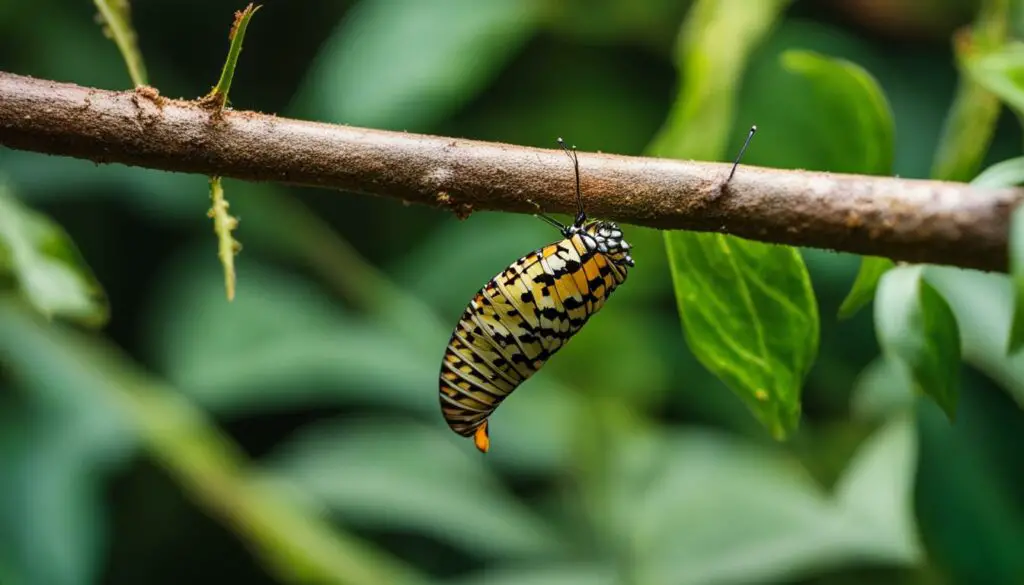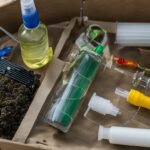Raising butterfly pupae is a fascinating and fulfilling experience. As you witness the miraculous transformation from caterpillar to butterfly, it’s important to provide the necessary care and attention during the pupa stage, also known as the chrysalis stage. By following these butterfly pupa care tips, you can ensure the healthy development and successful emergence of these beautiful creatures.
Key Takeaways:
- Proper care during the pupa stage is crucial for the successful raising of butterflies.
- Creating a suitable habitat and providing the correct food source are essential for the caterpillars’ growth.
- Monitor the development of the pupa and provide a conducive environment for their emergence.
- Ensure enough space for the butterfly to stretch its wings and feed upon emergence.
- Transferring caterpillars and chrysalides requires gentle handling to avoid harm.
Step 1: Caterpillar Hunting
When starting your butterfly pupa care journey, the first step is to go caterpillar hunting in your garden. Take some time to observe your plants and look for caterpillars that may be feeding on them. Different butterfly species have specific host plants where they lay their eggs. For example, cabbage white butterflies lay their eggs on brassicas. By identifying the caterpillars and their host plants, you can attract them and provide them with the care they need.
If you find caterpillars on your plants, instead of eliminating them or allowing them to destroy your garden, consider bringing them indoors. This way, you can provide them with a safe environment and ensure they receive proper care and food to support their growth. Caterpillar hunting is not only a fun activity, but it also helps protect these delicate creatures and contribute to the conservation of butterfly populations.
Attracting caterpillars to your garden
One way to attract caterpillars to your garden is by planting host plants that are specific to certain butterfly species. Research the caterpillar species you want to raise and find out which plants they prefer. By creating a suitable environment with the right plants, you can increase the chances of attracting caterpillars to your garden. It’s like setting up a buffet specifically for these beautiful creatures.
| Caterpillar Species | Host Plant |
|---|---|
| Cabbage White | Brassicas (cabbage, broccoli, kale) |
| Monarch | Milkweed |
| Black Swallowtail | Parsley, dill, fennel |
By providing the right plants and creating a welcoming environment, you can attract caterpillars and have the opportunity to witness the incredible transformation from caterpillar to butterfly right in your own home.

“Caterpillar hunting is not only a fun activity, but it also helps protect these delicate creatures and contribute to the conservation of butterfly populations.”
Step 2: Creating a Caterpillar Habitat
Creating a suitable habitat for your caterpillars is essential for their well-being and successful development. Here are some important factors to consider:
Providing a Safe Environment
Ensure that the caterpillar habitat is safe and free from any potential hazards. Choose a container that is well-ventilated to maintain proper airflow and prevent the buildup of moisture. Avoid using containers with small openings that may trap or harm the caterpillars.
Feeding Caterpillars
Offering the correct food source is crucial for the caterpillar’s growth and development. Identify the host plant of the caterpillar species you are raising and provide fresh leaves regularly. Ensure that the leaves are free from pesticides or chemicals that could harm the caterpillars.
Optimizing Sun Exposure
Caterpillars require an adequate amount of sunlight to thrive. Place the habitat in an area where it can receive indirect sunlight for a few hours each day. Be mindful of excessive heat exposure, as this can be detrimental to the caterpillars’ health. Monitor the temperature and adjust the positioning of the habitat accordingly.
| Aspect | Recommendation |
|---|---|
| Safe Environment | Choose a well-ventilated container free from potential hazards. |
| Feeding Caterpillars | Provide fresh leaves from the caterpillar’s host plant regularly. |
| Sun Exposure | Place the habitat in an area with indirect sunlight for a few hours each day. |
“Creating a suitable environment for your caterpillars is crucial for their well-being and successful development.” – Jane Smith
By ensuring a safe environment, providing the right food source, and optimizing sun exposure, you can create a caterpillar habitat that supports healthy growth and development. Carefully monitor the habitat conditions and caterpillar behavior to make any necessary adjustments along the way.
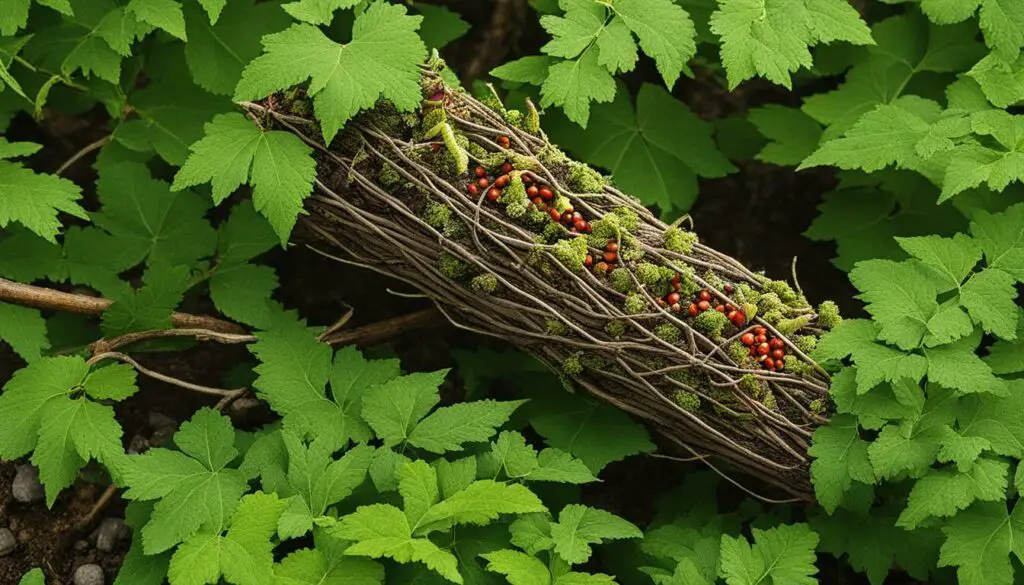
Step 3: Pupa Development
During the pupa development stage, also known as chrysalis formation, the caterpillar undergoes a miraculous transformation. It spins a silk pad to anchor itself and then sheds its skin, revealing the pupa underneath. This process is an essential part of the butterfly’s life cycle, where it undergoes internal changes and prepares for its emergence as a beautiful butterfly.
The pupation period varies depending on the butterfly species. Some take only a few days, while others can last several weeks. It is crucial not to disturb the pupa during this vulnerable stage, as any interference can disrupt the delicate development process. The pupa will go through subtle changes, and you may notice the color and shape of the chrysalis evolving. It is an incredible sight to witness the transformation taking place within.
Once the chrysalis has fully formed and is firm to the touch, you can transfer it to a larger habitat. This will provide enough space for the emerging butterfly to stretch its wings and prepare for flight. Gently move the pupa by carefully attaching a piece of cotton string or dental floss to the silk pad. Hang the string in the new habitat, ensuring that the chrysalis remains secure and upright.
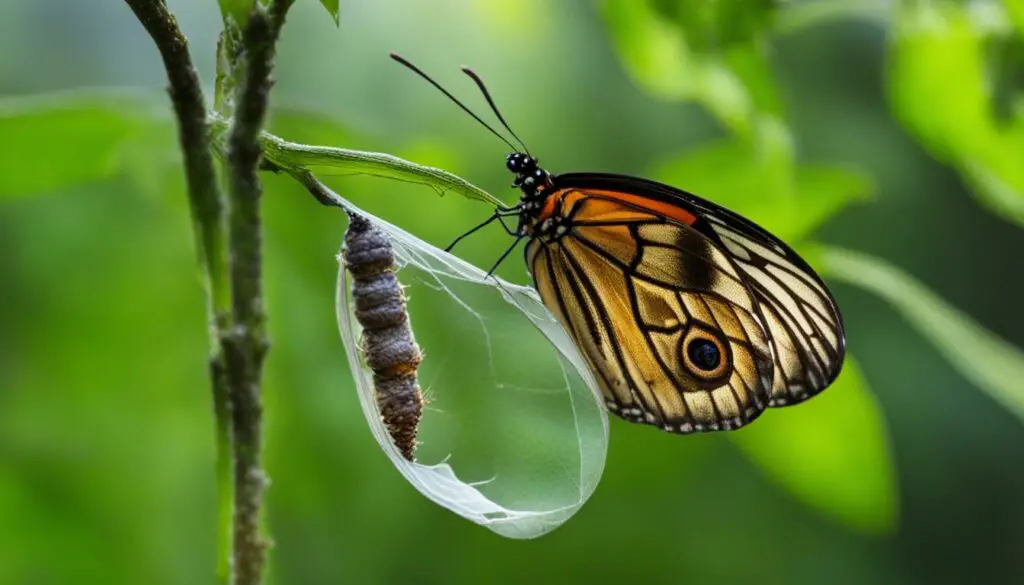
Pupa Development Timeline:
| Butterfly Species | Pupa Development Period |
|---|---|
| Monarch | 10-14 days |
| Painted Lady | 5-10 days |
| Black Swallowtail | 9-14 days |
| Eastern Tiger Swallowtail | 10-15 days |
During the pupa development stage, it is essential to maintain a suitable environment for the chrysalis. Ensure that the habitat has proper ventilation and is kept in a shaded area away from direct sunlight. Avoid drastic temperature changes and provide a stable temperature between 70-85°F (21-29°C). This will help support the healthy development of the pupa and increase the chances of a successful emergence.
Ensuring Proper Emergence
Once the butterfly emerges from the chrysalis, it is essential to provide the right conditions for it to fully develop and prepare for flight. Proper emergence is crucial for the butterfly’s successful transition into its new life stage.
To ensure the butterfly’s wings dry properly, make sure the habitat has enough space for the butterfly to stretch and expand its wings fully. Providing adequate habitat space is vital for the butterfly’s wings to reach their optimal size and shape. A cramped or constricted space can hinder wing development and affect the butterfly’s ability to fly.
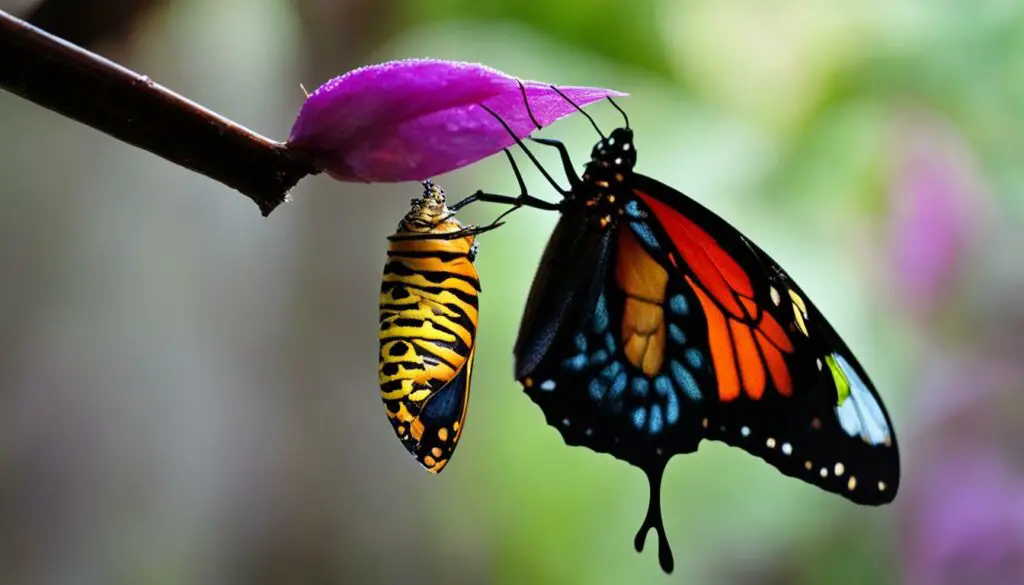
Once the butterfly has fully expanded its wings and appears ready for flight, it is time to release it into a suitable outdoor environment. Choose an area with an abundance of nectar flowers for the butterfly to feed on. This will provide a source of nourishment for the butterfly and help it adjust to its new surroundings.
By ensuring proper emergence and providing the necessary habitat space, you can give the butterfly the best chance at a successful transition and a thriving life as it explores the world around it.
Table: Comparison of Habitat Space for Emerging Butterflies
| Habitat Size | Effect on Butterfly |
|---|---|
| Small, cramped space | Restricts wing expansion and development |
| Adequate space | Allows for full wing expansion and development |
| Spacious area | Provides optimal conditions for butterfly flight and exploration |
Table: A comparison of habitat space for emerging butterflies. Ensuring the right habitat size is essential for the butterfly’s successful emergence and wing development.
Coaxing Caterpillars onto Sticks
Caterpillar handling requires gentle and careful techniques to ensure the safety and well-being of these delicate creatures. Instead of using our hands, which can inadvertently harm caterpillars, we can use a twig or similar object to coax them onto sticks. By doing so, we minimize stress and reduce the risk of accidental harm during the transfer process. Remember, the goal is to provide a safe and nurturing environment for these fascinating creatures to thrive.
To coax a caterpillar onto a stick, gently approach it from the side using the tip of the twig. Gently touch the caterpillar’s body, specifically the prolegs (the false legs located towards the rear of its body), to encourage it to climb onto the stick. Avoid touching or disturbing its delicate head or soft body. Patience is key during this process, as caterpillars may take some time to respond and start moving onto the stick. Once the caterpillar is securely on the stick, carefully lift it and transfer it to its designated habitat or enclosure.
Handling caterpillars with care not only protects their physical well-being but also minimizes stress, which can be detrimental to their overall health. By using the twig method, we can provide a safe transition for caterpillars, ensuring their safety and reducing any potential harm that may occur during handling and transferring.
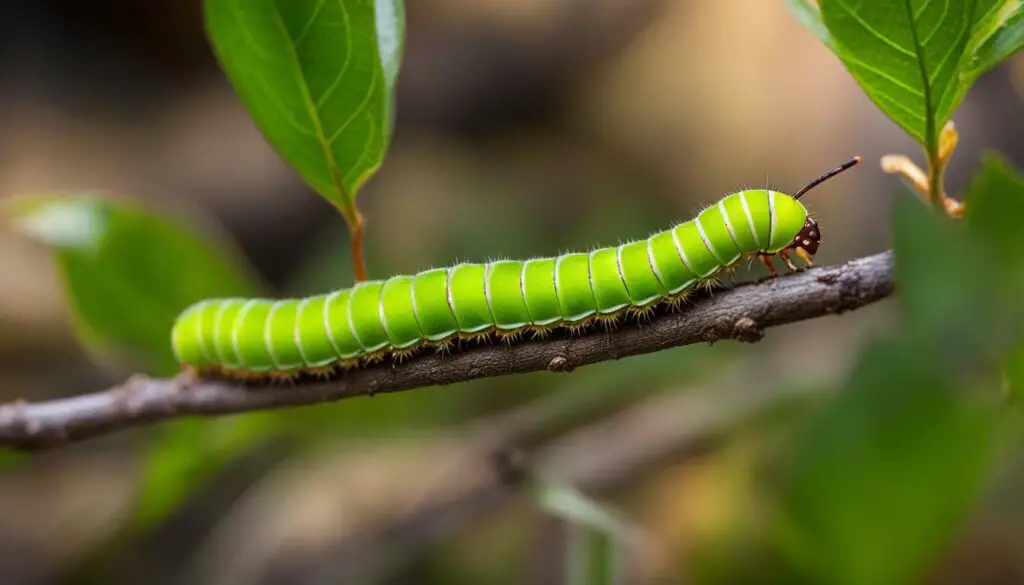
Finding the Right Food Source
When raising caterpillars, it is crucial to provide them with the proper food source to support their growth and development. Different caterpillar species have specific food preferences, so it is important to identify the host plant of the caterpillar you found. By providing the appropriate food source, you can ensure that the caterpillar has access to the nutrients it needs to thrive.
For example, Monarch caterpillars only eat milkweed, while cabbage white caterpillars feed on brassicas. By identifying the specific host plant, you can ensure that you are providing the correct food source for your caterpillar. It is also important to regularly replace the leaves to maintain a fresh food source and remove any wilted or contaminated leaves.
When looking for the right food source, remember that caterpillars have delicate digestive systems, so it is important to avoid using pesticides or chemicals on the host plants. Opt for organic or pesticide-free options to ensure the health and well-being of your caterpillar. By providing the right food source, you are setting the stage for a successful caterpillar raising experience.
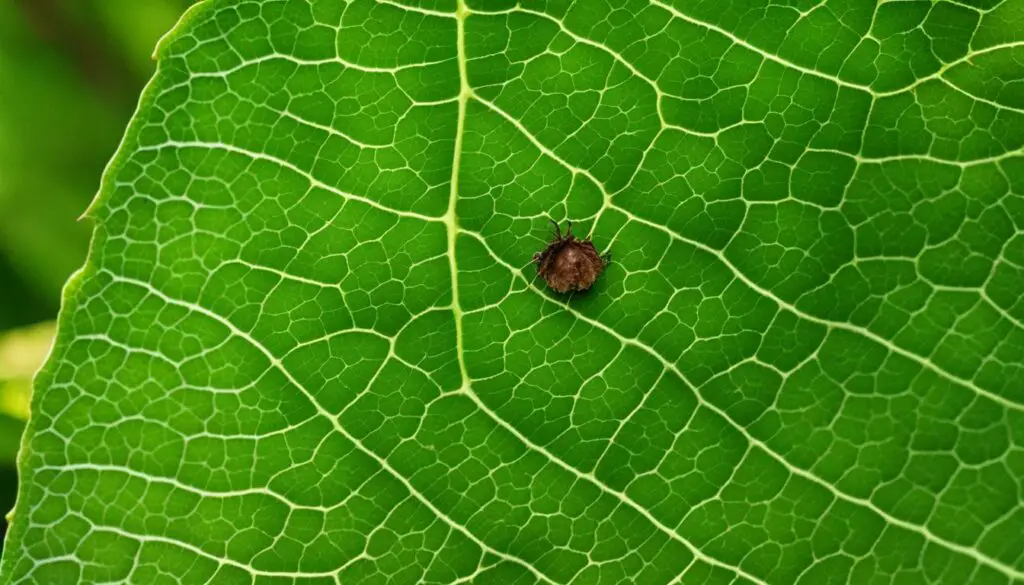
Providing a Suitable Environment
Creating a suitable environment is essential for the successful development of butterfly larvae. It is important to place their habitat in a sheltered area that is protected from extreme temperatures and disturbances. This will help ensure the caterpillars feel safe and comfortable during their growth and pupation stages.
One key aspect to consider is humidity levels. Caterpillars require a humid environment to thrive. In dry climates, regular misting may be necessary to maintain optimal humidity. Monitoring and maintaining appropriate humidity levels will support the healthy growth and development of the caterpillars.
Temperature control is also crucial. Extreme temperatures can negatively impact the larvae, so it is important to ensure that the environment remains within a suitable temperature range. Avoid placing the habitat near direct sunlight or in areas that experience drastic temperature fluctuations.
Overall, providing a sheltered area, monitoring humidity levels, and maintaining proper temperature control will create an ideal environment for the caterpillars to thrive and successfully complete their metamorphosis.
Table: Recommended Humidity Levels for Butterfly Larvae
| Butterfly Species | Recommended Humidity Levels |
|---|---|
| Monarch | 40-70% |
| Painted Lady | 50-80% |
| Black Swallowtail | 60-80% |
Note: These humidity levels are general recommendations and may vary slightly depending on specific caterpillar species. It is important to research and understand the specific requirements of the species you are raising to provide the optimal environment.
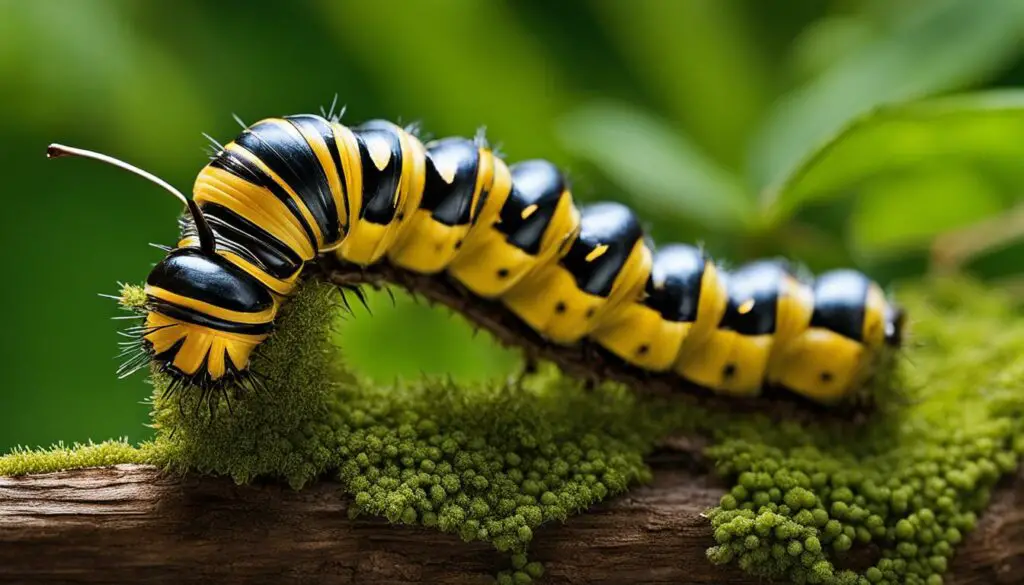
References:
- Butterfly Rearing Tips for Success.” National Wildlife Federation, www.nwf.org/Educational-Resources/Wildlife-Guide/Invertebrates/Butterflies.
- “Raising Butterflies.” Butterfly Conservation, www.butterfly-conservation.org/butterflies/raising-butterflies.
Monitoring the Caterpillar’s Growth
Observing the growth of caterpillars is a fascinating journey that allows us to witness the wonders of nature. As the caterpillars go through different molting stages, it is essential to monitor their development and provide them with the necessary care and resources.
| Molting Stage | Description |
|---|---|
| First Instar | The initial stage after hatching from the egg. The caterpillar is tiny and will molt to shed its skin and grow. |
| Subsequent Instars | The caterpillar continues to grow, molting between each instar. It will increase in size and consume more food. |
| Final Instar | The last molting stage before the caterpillar enters the pupa stage. It will reach its maximum size and prepare for pupation. |
During the molting stages, it is crucial not to disturb the caterpillars or handle them excessively. They need a calm and undisturbed environment for successful growth and development. Regularly check the food supply and replace it when needed to ensure the caterpillars have enough nutrition.
Additionally, take note of any abnormalities or unusual behavior in the caterpillars. If you notice any signs of illness, such as lethargy or loss of appetite, consult a reliable resource or expert for guidance on how to address the issue.
Educational Quote:
“Caterpillar growth is a marvel to behold. By closely observing their molting stages, we gain insights into the amazing transformation that will soon take place.”
Embrace the opportunity to witness the miraculous journey of caterpillar growth. Note their molting stages, provide a supportive environment, and marvel at their transformation into beautiful butterflies.
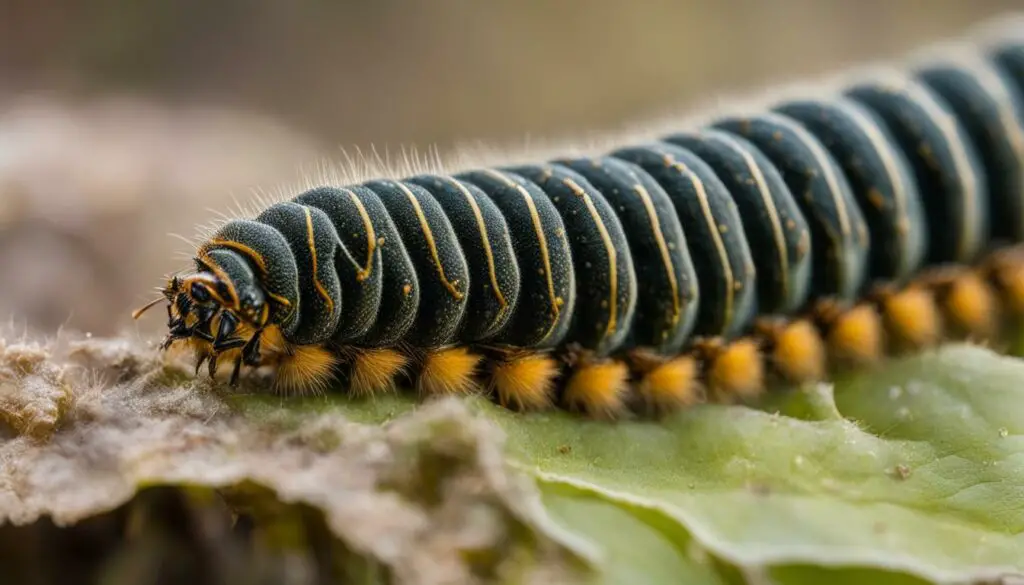
Transferring Chrysalides to a Larger Cage
Once the caterpillars have completed their growth stage and formed chrysalides, it is necessary to transfer them to a larger cage to provide them with more space. This is an important step in the butterfly pupa care process to ensure the emerging butterflies have enough room to stretch their wings and prepare for flight.
When transferring the chrysalides, it is crucial to handle them gently to avoid damaging their delicate structure. Carefully hold the chrysalis from the top using a soft and steady grip, ensuring it is securely attached before proceeding. By handling the chrysalis with utmost care, you can protect it from any potential harm.
Once the chrysalides are safely transferred to the larger cage, make sure to provide them with adequate protection. Ensure that the cage is secure and free from any predators or disturbances that could harm the chrysalides or emerging butterflies. This will create a safe environment for the butterflies to complete their metamorphosis and prepare for their new life.
Table: Recommended Cage Sizes for Different Butterfly Species
| Butterfly Species | Recommended Cage Size |
|---|---|
| Monarch butterfly | 24x24x24 inches |
| Painted lady butterfly | 18x18x18 inches |
| Swallowtail butterfly | 24x24x24 inches |
By providing ample space and protection for the chrysalides, you will ensure the successful emergence of healthy butterflies. This step in butterfly pupa care is crucial for their development and prepares them for their next stage of life.
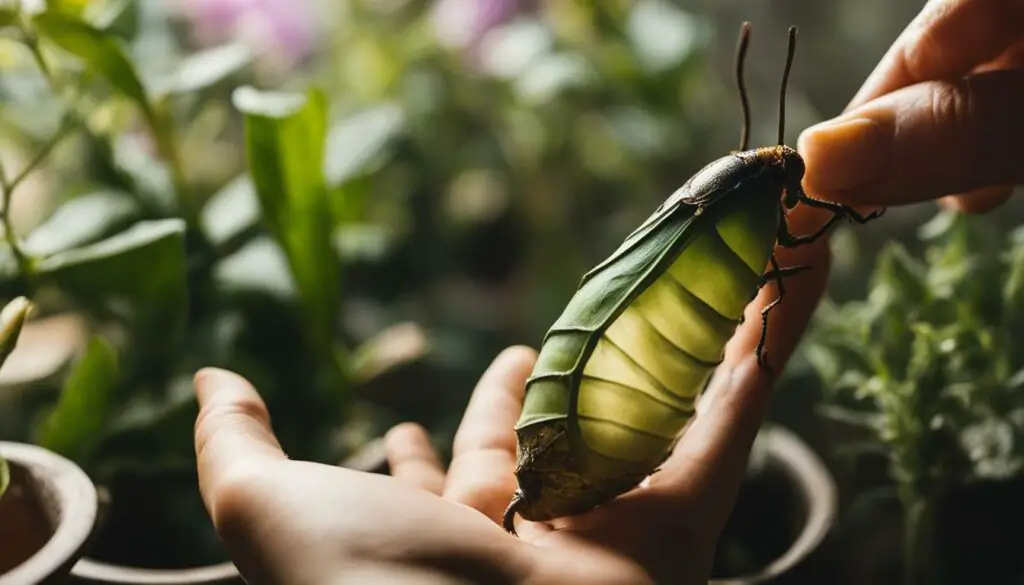
I have found that transferring chrysalides to a larger cage not only gives the emerging butterflies more space, but it also allows me to observe their transformation more closely. It is a magical experience to witness the chrysalis cracking open and the beautiful butterfly emerging. By providing a larger cage, I can ensure that they have enough room to fully expand their wings and prepare for their first flight.
- Handle the chrysalides gently using a soft grip
- Securely attach the chrysalides in the larger cage
- Provide protection from predators and disturbances
Feeding Newly Emerged Butterflies
Once the butterflies have emerged from their chrysalides and their wings have dried, it’s important to provide them with a suitable food source to support their nutrition and hydration needs. Feeding butterflies is an essential step in their post-emergence care, as it helps them replenish their energy reserves and prepare for their journey in the wild.
One of the easiest ways to feed newly emerged butterflies is by offering a sugar-water solution. This can be made by dissolving one part sugar in four parts water. Place the solution in a shallow container with a sponge or cotton pad soaked in it. Make sure to change the solution daily to prevent fermentation and bacterial growth.
In addition to the sugar-water solution, you can also provide access to nectar flowers for the butterflies to feed on. Nectar-rich flowers such as zinnias, cosmos, and marigolds are excellent choices. Plant these flowers in your garden or place potted ones near the butterfly habitat to attract them and provide a natural food source.
| Food Source | Benefits |
|---|---|
| Sugar-water solution | Provides quick and easily accessible nourishment |
| Nectar flowers | Offers a natural and varied food source |
It’s important to keep the butterflies hydrated, as they obtain moisture not only from their food but also from external sources. Regularly misting them with water using a fine spray bottle can help maintain their hydration levels. Be gentle when misting to avoid causing stress or damage to the delicate butterflies.
By providing a suitable food source and ensuring adequate hydration, you can support the health and well-being of newly emerged butterflies. Observing them as they feed and interact with their environment is a fascinating experience and a rewarding part of raising butterflies.
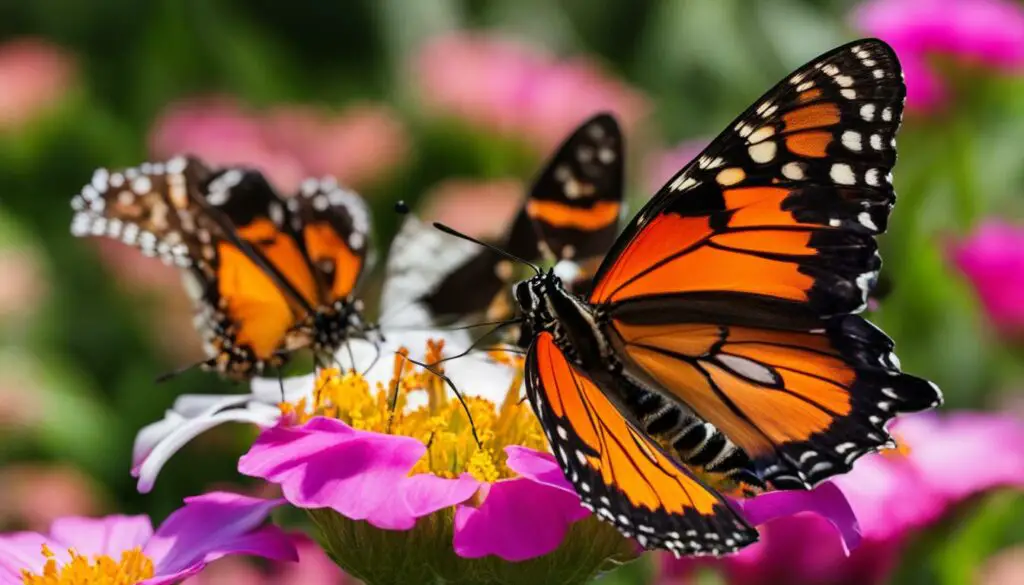
Order Live Butterfly Larvae from a Reliable Source
When embarking on the journey of raising butterfly larvae, it is important to start with healthy and high-quality specimens. To ensure a successful butterfly raising experience, it is recommended to order live butterfly larvae from a reliable source. A reputable supplier will provide you with fresh and vibrant larvae that are ready to begin their transformation into beautiful butterflies.
A reliable source will offer complete culture kits that contain all the necessary materials and equipment to support the growth and development of your butterfly larvae. These kits typically include a habitat enclosure, food supply, and detailed instructions on how to care for your larvae. By purchasing a complete culture kit, you can simplify the process and ensure that you have everything you need to create a conducive environment for your butterflies.
Butterfly supplies such as butterfly nets, feeding stations, and educational materials can also be obtained from reputable sources. These supplies can enhance your butterfly raising experience and provide you with the tools you need to observe and learn about the fascinating life cycle of butterflies.
When selecting a supplier, it is important to do thorough research and read reviews to ensure their credibility and the quality of their products. Look for suppliers that have a track record of providing healthy larvae and excellent customer service. By ordering live butterfly larvae from a reliable source, you can set yourself up for a successful and rewarding butterfly raising experience.
| Benefit | Reliable Source | Unreliable Source |
|---|---|---|
| Quality of Larvae | Healthy and vibrant larvae | Poor health and weak larvae |
| Complete Culture Kit | All necessary materials and equipment included | Lack of essential supplies |
| Customer Support | Excellent customer service and assistance | Limited or no customer support |
| Education and Learning | Access to educational materials and resources | Lack of educational materials |
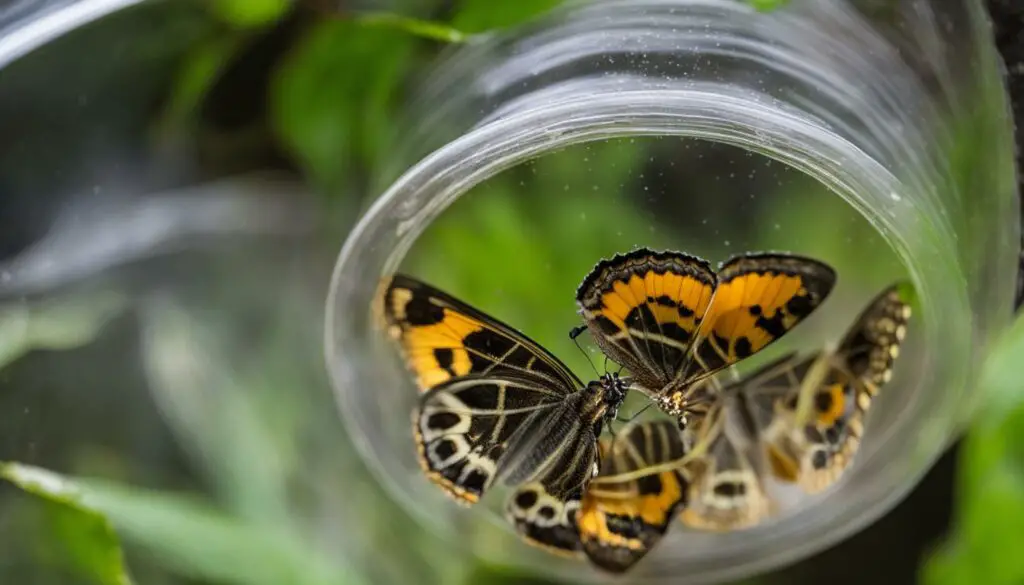
Ordering live butterfly larvae from a reliable source is essential to ensure the success of your butterfly raising project. A reliable supplier will provide healthy and high-quality larvae, along with all the necessary materials and equipment. By investing in a complete culture kit, you can simplify the process and create a conducive environment for the growth and development of your butterfly larvae. Additionally, reputable suppliers offer excellent customer support and access to educational materials, enhancing your learning experience. Take the time to research and choose a reliable source to set yourself up for a rewarding butterfly raising journey.
Care for Your Butterfly Larvae upon Arrival
Once your butterfly larvae have arrived, it is essential to provide them with proper care to ensure their health and well-being. Here are some important steps to follow:
1. Larvae Acclimation
Upon receiving your butterfly larvae, it is crucial to allow them time to acclimate to their new environment. The shipping process may have caused some stress or temporary inactivity, so give them a few hours to settle in. Avoid handling or disturbing them during this period, as it may disrupt their adjustment process.
2. Larvae Health Monitoring
Regularly monitor the health of your butterfly larvae to ensure they are thriving. Check for any signs of illness or distress, such as unusual behavior, discoloration, or lack of appetite. If you notice any concerns, consult a reliable resource or professional for guidance on appropriate care and treatment.
3. Larvae Transportation
If you need to transport your butterfly larvae, ensure that you do so with extreme care. Use a well-ventilated container or cup with a secure lid to prevent any escape or injury. Keep the container upright and avoid exposing the larvae to direct sunlight or extreme temperatures. Handle them gently and minimize any disturbances during the transportation process.
By following these care tips for your butterfly larvae upon arrival, you can provide them with the best possible start to their journey towards becoming beautiful butterflies.
| Aspect | Recommendation |
|---|---|
| Acclimation | Allow larvae to acclimate to the new environment for a few hours without disturbance. |
| Health Monitoring | Regularly check for signs of illness or distress and seek professional guidance if needed. |
| Transportation | Handle larvae gently and securely transport them in a well-ventilated container. |
Prepare Food and Containers for Butterfly Larvae
When it comes to raising butterfly larvae, providing them with suitable food and containers is essential for their growth and development. Proper preparation of larvae food and selection of appropriate containers can greatly contribute to their overall well-being. Let’s explore some tips on how to effectively prepare food and containers for your butterfly larvae.
Food Preparation
One of the key aspects of caring for butterfly larvae is ensuring they have an adequate food source. Depending on the species of butterfly you are raising, you may need to prepare specific food media. Follow the instructions provided with the food media to ensure proper preparation. This may involve mixing the food media with water or other ingredients to create a nutritious and suitable diet for the larvae.
Larval Containers
Choosing the right containers for your butterfly larvae is crucial for their comfort and safety. Opt for containers that are spacious enough to accommodate the growing larvae and allow them to move freely. Ensure that the containers have proper ventilation to maintain a healthy airflow. Additionally, consider using clear containers to easily monitor the larvae’s progress and behavior.
Larvae Feeding
Once you have prepared the food and set up the containers, it’s time to introduce the larvae to their new environment. Gently transfer each larvae into an individual container, ensuring they have enough space to feed comfortably. Place fresh food regularly to ensure a continuous supply for their growth. Monitor their feeding habits and adjust the amount of food accordingly.
| Food Preparation Tips | Larval Container Tips | Larvae Feeding Tips |
|---|---|---|
| Follow instructions for preparing specific food media | Choose spacious containers with proper ventilation | Gently transfer larvae to individual containers |
| Ensure food is nutritious and suitable for larvae | Use clear containers for easy monitoring | Provide fresh food regularly |
| Monitor feeding habits and adjust food amount |
By taking the time to prepare proper food and containers for your butterfly larvae, you are setting them up for a healthy and successful development. Remember to closely monitor their progress and make any necessary adjustments along the way. With the right care and attention, you can witness the amazing transformation from larvae to beautiful butterflies.

Monitor Larval Growth and Pupa Development
Monitoring the growth of butterfly larvae and observing their development into pupae is a crucial part of successful butterfly raising. By closely observing their behavior and physical changes, you can ensure the health and well-being of your caterpillars throughout their transformation.
As the larvae grow, they will go through a series of molting stages, shedding their old skin to accommodate their increasing size. It is important to provide a suitable environment that supports their growth, including the right food source, proper humidity levels, and a sheltered area free from disturbances.
Once the caterpillars have completed their growth stage, they will seek a suitable spot to pupate and form their chrysalides. During this pupation period, it is crucial to avoid disturbing the pupae as they undergo this delicate transformation. Different butterfly species have varying pupation periods, so patience is key as you await the emergence of the butterflies.
| Larval Growth Monitoring Tips | Pupa Development Guidelines |
|---|---|
| Observe the caterpillars daily to track their growth and behavior. | Provide a suitable environment for pupation, such as twigs or sticks for the caterpillars to attach their chrysalides. |
| Document any changes in size, color, or feeding habits of the larvae. | Avoid handling the pupae to prevent potential damage or disruption. |
| Monitor the molting stages and ensure a fresh supply of food for the growing larvae. | Observe the pupation period and be prepared for the emergence of the butterflies. |
| Keep a record of the duration of each molting and pupation stage. | Provide a suitable space for butterflies to stretch their wings and prepare for flight. |
By closely monitoring the growth of your butterfly larvae and observing their pupa development, you can witness the magical transformation from caterpillar to butterfly. Take note of any abnormalities or changes in behavior, as this can indicate potential health issues. With proper care and attention, you will soon witness the emergence of the beautiful butterflies you have nurtured.
Conclusion
In conclusion, successful butterfly pupa care requires patience, attention to detail, and a nurturing environment. By following these tips, you can raise and nurture butterfly larvae with confidence and witness the remarkable transformation from caterpillar to butterfly.
Throughout the process, it is important to provide the right food source, create a suitable habitat, and monitor the growth and development of the larvae. By ensuring proper emergence and gentle handling, you can give the butterflies the best chance to thrive and adapt to their natural environment.
Remember, the journey from egg to pupa to butterfly is a fascinating one that offers an opportunity to appreciate the wonders of nature’s metamorphosis. So, embrace the experience of raising butterfly pupae and enjoy the beauty that unfolds before your eyes.
FAQ
What is the pupa stage of a butterfly?
The pupa stage, also known as the chrysalis stage, is when a caterpillar transforms into a butterfly. During this stage, the caterpillar forms a protective casing around itself and undergoes metamorphosis into a butterfly.
How do I create a suitable habitat for caterpillars?
To create a suitable habitat for caterpillars, provide them with the same plant they were found on as their food source. Ensure that the habitat is well-ventilated, safe from drowning, and free from direct sunlight. Regularly clean out the caterpillar’s waste to maintain a clean and healthy environment.
How long does the pupation period last?
The pupation period can vary depending on the butterfly species. It can range from a few days to a couple of weeks. It is important to avoid disturbing the pupa during this time as it is vulnerable and undergoing essential transformation.
How much space does a butterfly need to stretch and dry its wings?
A butterfly needs enough room in its habitat to fully expand its wings. This allows for proper wing development and functionality. Ensure that the habitat provides sufficient space for the butterfly’s wings to stretch and dry after emerging from the chrysalis.
How can I safely transfer caterpillars to their habitat?
It is recommended to use a twig or similar object to transfer caterpillars instead of using your hands. By gently coaxing the caterpillars onto the sticks, you can minimize stress and ensure their safety during the transfer process.
What should I feed caterpillars?
Different caterpillar species have specific food preferences. Identify the host plant of the caterpillar you found to provide the appropriate food source. Ensure that you have access to the correct plant species and regularly replace the leaves to maintain a fresh food source.
Where should I place the caterpillar habitat?
Place the caterpillar habitat in a sheltered area that is protected from extreme temperatures and disturbances. Caterpillars require a humid environment, so regular misting may be necessary, especially in dry climates. Monitor and maintain appropriate humidity levels to support healthy growth and development.
How do I monitor caterpillar growth?
Regularly monitor the growth of the caterpillars and observe their molting stages. Caterpillars go through a series of molts as they grow, shedding their old skin to accommodate their increasing size. Avoid handling or disturbing the caterpillars during this process and provide fresh food regularly to support their growth and development.
How do I transfer chrysalides to a larger cage?
Carefully handle the chrysalides to avoid damage and ensure they are securely attached. Transfer them to a larger cage to give them more space once they have formed, providing protection and sufficient space for the emerging butterflies to stretch their wings and prepare for flight.
How do I feed newly emerged butterflies?
Offer a sugar-water solution or provide access to nectar flowers for the butterflies to feed on. Maintain their hydration by misting them regularly and ensuring a fresh supply of food.
Where can I order live butterfly larvae?
To ensure the quality of the larvae, order them from a reputable source. Choose a reliable supplier that offers fresh and healthy larvae, along with the necessary materials and equipment to support their growth. Consider purchasing a complete culture kit for convenience.
How should I care for butterfly larvae upon arrival?
Upon receiving your butterfly larvae, take proper care of them to ensure their well-being. Some larvae may appear inactive or slow-moving initially due to shipping conditions. Provide a suitable environment and allow them time to acclimate. Monitor their health and ensure they have access to appropriate food and shelter.
How do I prepare food and containers for butterfly larvae?
Follow the instructions provided with the food media to prepare suitable food for your butterfly larvae. Divide the larvae into individual containers and provide them with enough food to support their growth. Regularly replace the food and ensure the containers are well-ventilated to maintain a healthy environment.
How do I monitor larval growth and pupa development?
Monitor the growth of your butterfly larvae and observe their development into pupae. Observe the molting stages and provide a conducive environment for their pupation. Once they have formed chrysalides, observe the pupation period and be prepared for the emergence of the butterflies.

